Posts Tagged star trek
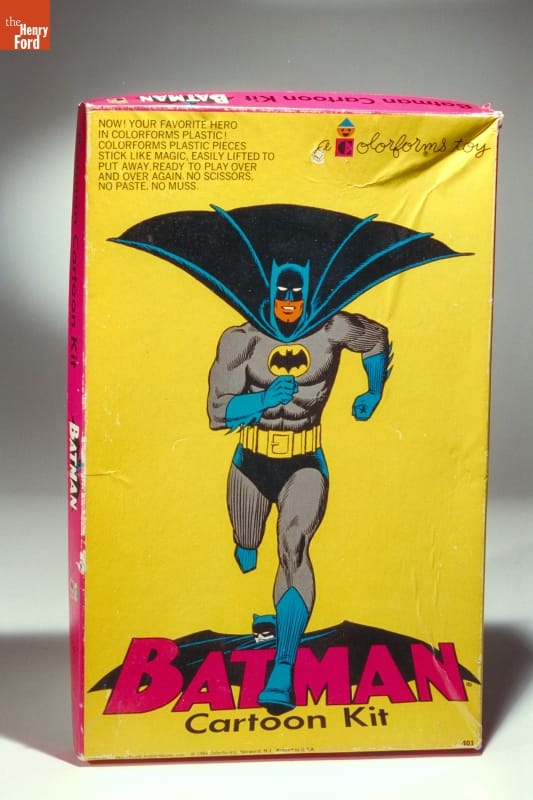
“Batman Cartoon Kit” Colorforms, 1966-68. THF 6651
It was the 1960s—the golden age of television. Some 95% of American homes boasted at least one TV. These were primarily black and white sets, as color TV was still out of the reach of many families. It’s hard to imagine now but there were only three channels at the time. Every year, the three networks (CBS, NBC, and ABC) vied for viewer ratings, shifting and changing shows and showtimes at two pivotal times during the television season—Fall and Winter.
As the Fall 1966 season unfolded, it became evident to TV viewers that something extraordinary was happening. Sure, there were the usual long-running sitcoms, like Green Acres, Petticoat Junction, and The Beverly Hillbillies. But change was in the wind. A new crop of programs emerged—colorful, fast-paced, poking fun at things that were supposed to be serious and exploring contemporary social issues.
Why the difference all of a sudden? Many of these shows were aimed at the youth audience, considered by this time an influential group of TV watchers. Others purposefully took advantage of the new color televisions. Sometimes show producers and creators were simply tired of the old formulas and wanted to break out of the box.
Let’s take a look at a few highlights from the 1966-67 TV season—starting with the staid and true and working up to the wild and wacky—and see what all the hubbub was about!
Walt Disney’s Wonderful World of Color (Sunday, 7:30-8:30 p.m., NBC)
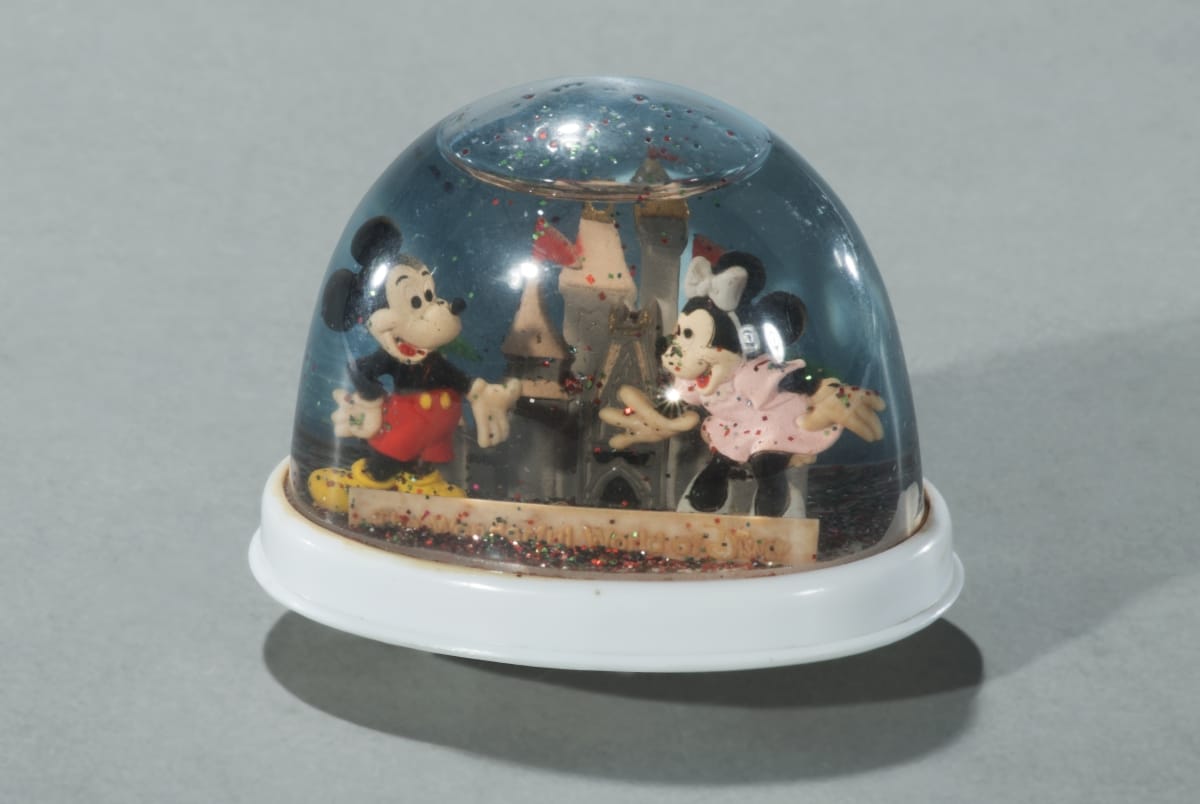
Snow Globe, “The Wonderful World of Disney,” 1969-79. THF174650
On Sunday nights since 1954, millions of Americans had tuned in to watch Walt Disney host his TV show, with a changing array of animated and live-action features, nature specials, movie reruns, travelogues, programs about science and outer space, and—best of all—updates on Walt Disney’s theme park, Disneyland. Since 1961, this show had been broadcast in color.
The 1966-67 season was particularly memorable because Walt Disney tragically passed away on December 15, 1966. But since the episodes had been pre-recorded, there was Walt still hosting them until April 1967. Viewers found this both comforting and disconcerting. Finally, after April, Walt was dropped as the host and, eventually, the show was retitled The Wonderful World of Disney. It ran with solid ratings until the mid-1970s.
Bonanza (Sunday, 9:00-10:00 p.m., NBC)
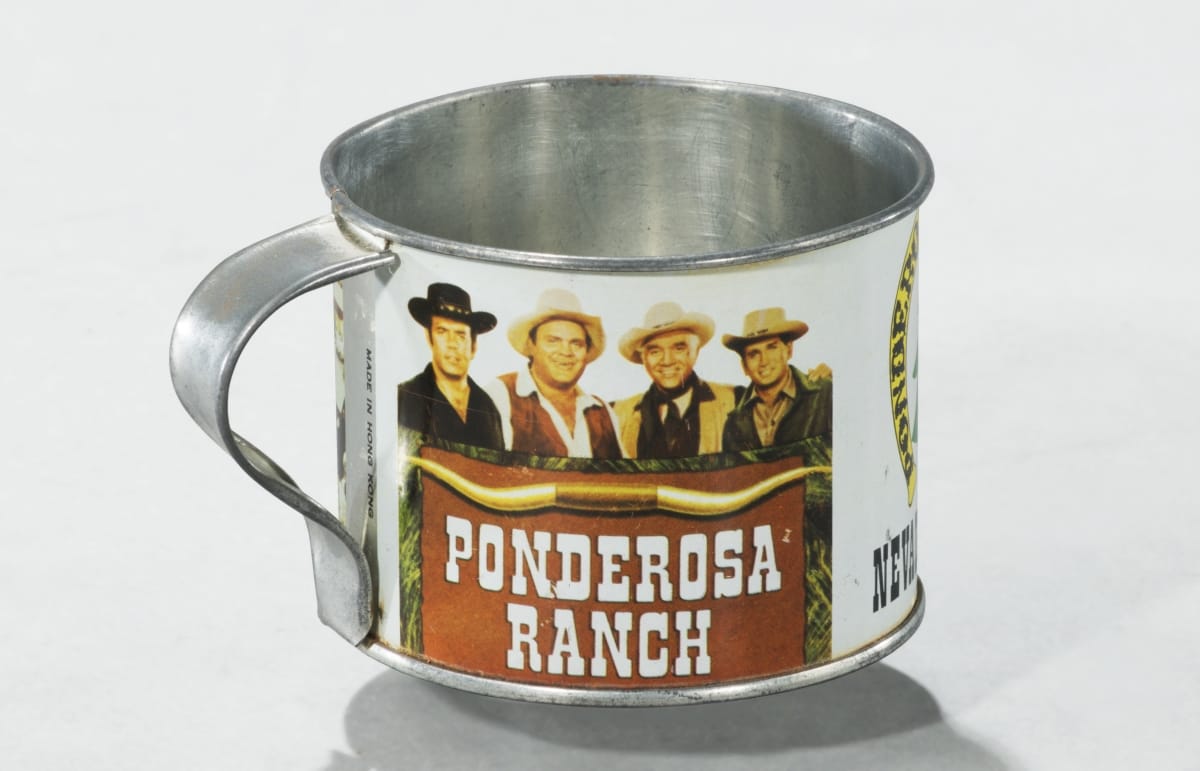
“Ponderosa Ranch” Mug, ca. 1970. THF174648
Viewership was high on NBC on Sunday nights at 9:00, as Bonanza was one of the most popular TV shows of all time. Running for 14 seasons and 430 episodes, this series about the trials and tribulations of widower Ben Cartwright and his three sons on the Ponderosa Ranch was an immediate breakout hit when it premiered in 1959, amidst a plethora of more run-of-the-mill prime-time westerns. Its popularity was primarily due to its quirky characters and unconventional stories—including early attempts to confront social issues. It was the first major western to be filmed in color and was the top-rated show on TV from 1964 to 1968. Bonanza ran until 1973.
The Man from U.N.C.L.E. (Friday, 8:30-9:30, NBC)
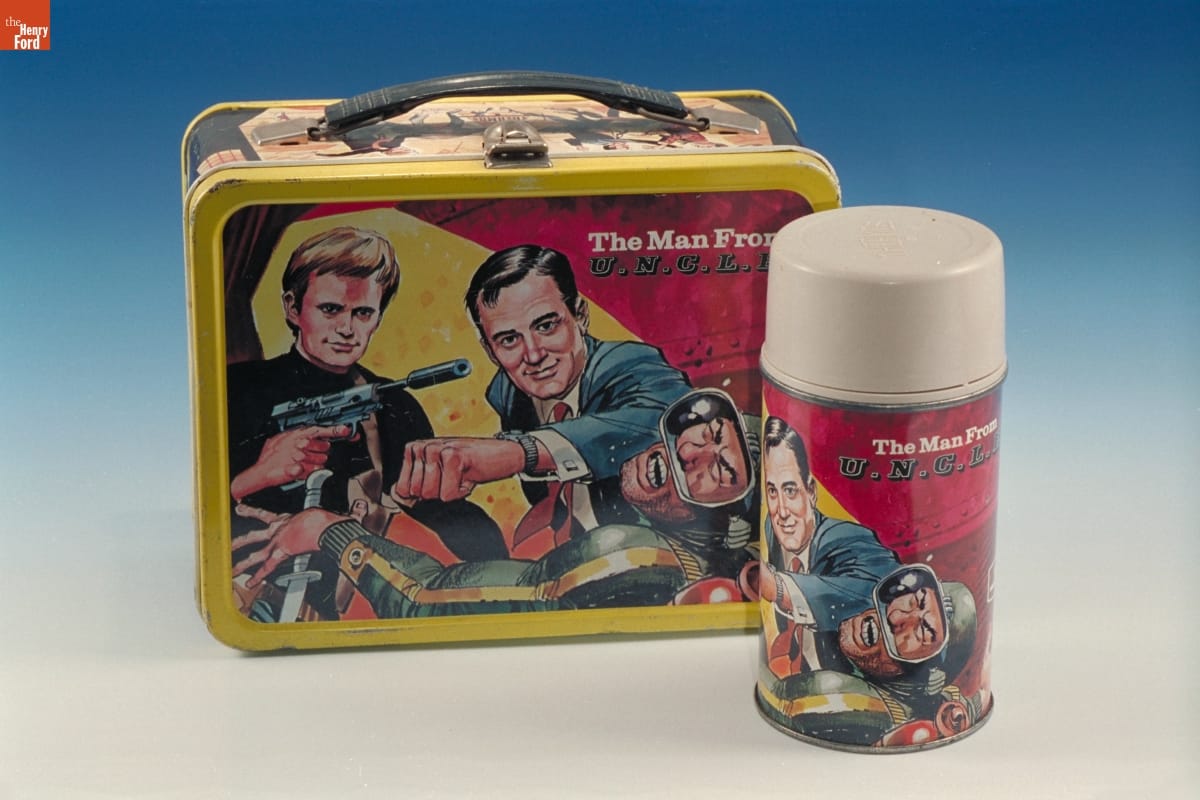
“The Man from U.N.C.L.E.” lunchbox and thermos, 1966. THF92303
Premiering in September 1964, The Man from U.N.C.L.E. took full advantage of the popularity of the spy genre launched by the James Bond film series. In fact, early concepts for it were conceptualized by Bond creator Ian Fleming. In this series, Napoleon Solo (originally conceived as the lone star) and Russian agent Ilya Kuryakin (added in response to popular demand) teamed up as part of a secret international counterespionage and law enforcement agency called U.N.C.L.E. (United Network Command for Law and Enforcement). Solo and Kuryakin banded together with a global organization of other agents to fight THRUSH, an international organization that aimed to conquer the world.
During this, the Cold War era, it was groundbreaking for a show to portray a United States-Soviet Union pair of secret agents, as these two countries were ideologically at odds most of the time. The Man from U.N.C.L.E. was also known for its high-profile guest stars and—taking a cue from the Bond films—its clever gadgets. In 1966, this series won the Golden Globe for Best Television Program and, building upon its popularity, spun off into two related double-feature movies that year. Unfortunately, attempting to compete with lighter, campier programs of the era, the producers made a conscious effort to increase the level of humor—leading to a severe ratings drop. Although the serious plot lines were soon reinstated, the ratings never recovered. The Man from U.N.C.L.E. was canceled in January 1968.
I Spy (Wednesday 10:00-11:00, NBC)
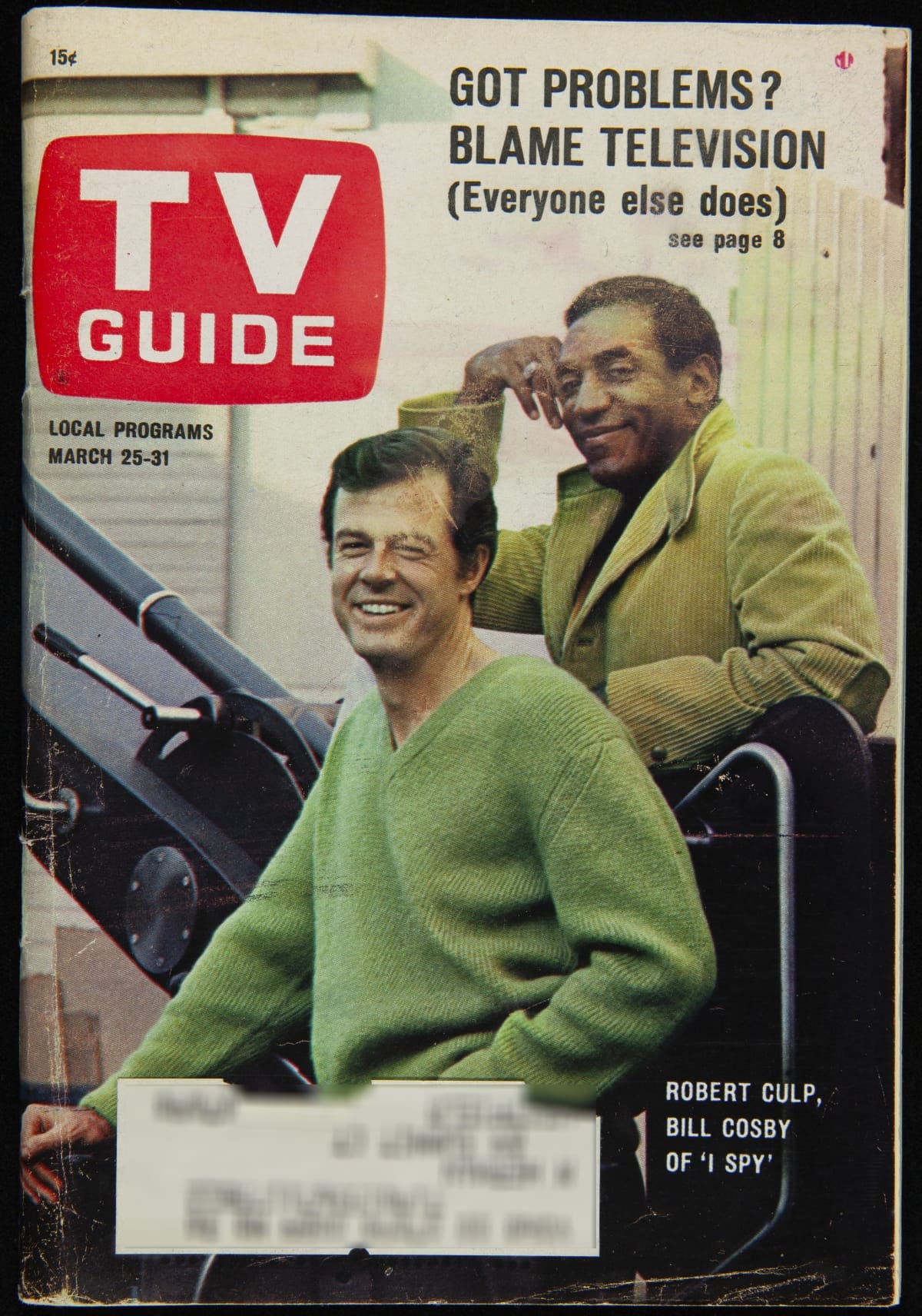
TV Guide featuring “I Spy” characters Robert Culp and Bill Cosby on cover, March 25-31, 1967. THF275655
One series that never opted for campy was I Spy, which starred Bill Cosby and Robert Culp playing two U.S. intelligence agents traveling undercover as international “tennis bums.” This series, which premiered in 1965, was also inspired by the James Bond film series and remained a fixture in the secret agent/espionage genre until cancelled in April 1968. I Spy, additionally a leader in the buddy genre, broke new ground as the first American TV drama series to feature a black actor in a lead role. It was also unusual in its use of exotic locations—much like the James Bond films—when shows like The Man from U.N.C.L.E. were completely filmed on a studio backlot.
I Spy offered hip banter between the two stars and some humor, but it focused primarily on the grittier side of the espionage business, sometimes even ending on a somber note. The success of this series was attributed to the strong chemistry between Culp and Cosby. Cosby’s presence was never called out in the way that black stars and co-stars were made a big deal of on later TV programs like Julia (1968) and Room 222 (1969).
Get Smart (Saturday, 8:30-9:00 NBC)
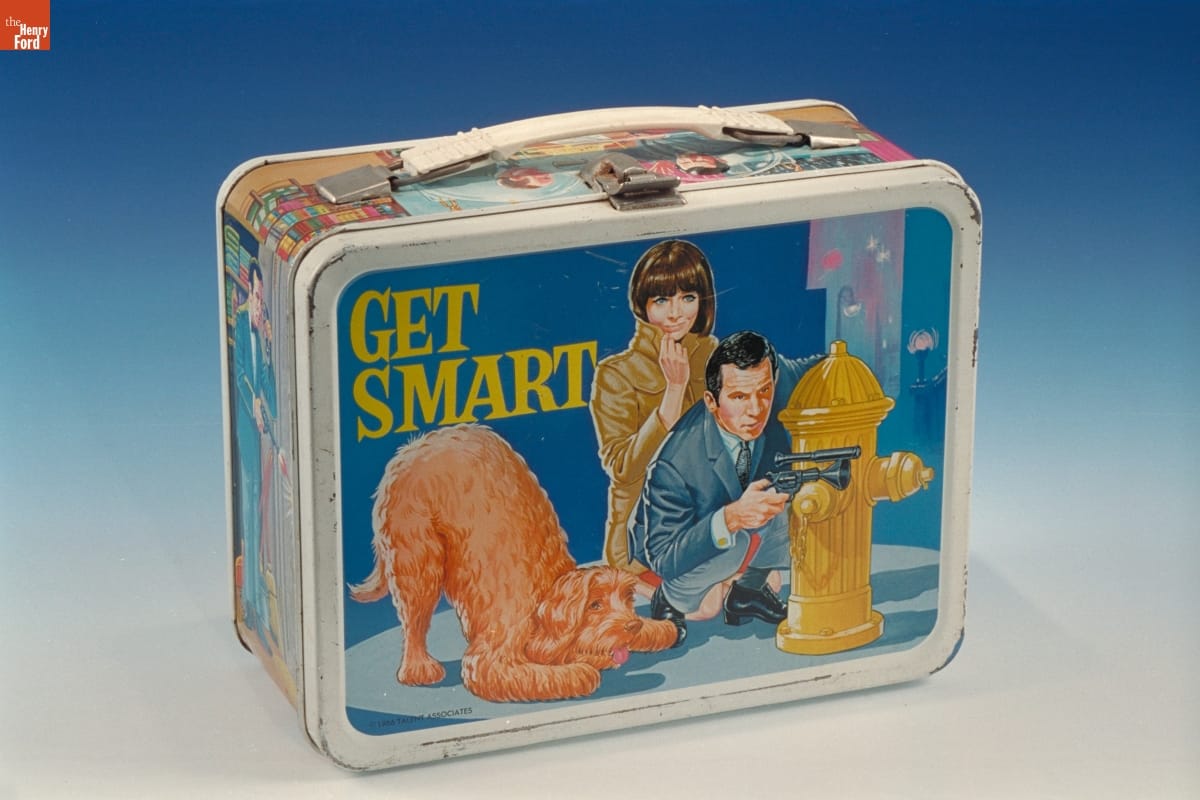
“Get Smart” Lunchbox, 1966. THF92304
Premiering in September 1965, Get Smart was a comedy that satirized virtually everything considered serious and sacred in the James Bond films and such TV shows as I Spy and The Man from U.N.C.L.E. Created by comic writers Mel Brooks and Buck Henry as a response to the grim seriousness of the Cold War spy genre, it starred bumbling Secret Agent 86—otherwise known as Maxwell “Max” Smart, along with supporting characters, female Agent 99 and the Chief. These characters worked for CONTROL, a secret U.S. government counterintelligence agency, against KAOS, “an international organization of evil.” Brooks and Henry also poked fun at this genre’s use of high-tech spy gadgets (Max’s shoe phone perhaps being the most memorable), world takeover plots, and enemy agents. Somehow, despite serious mess-ups in every episode, Maxwell Smart always emerged victorious in the end.
Get Smart was considered groundbreaking for broadening the parameters of TV sitcoms but was especially known for catchphrases like “Would you believe…” and “Sorry about that, Chief.” Despite a declining interest in the secret-agent genre, Get Smart’s talented writers attempted to keep it fresh until it was finally cancelled in May 1970.
Batman (Wednesday and Thursday, 7:30-8:00, ABC)
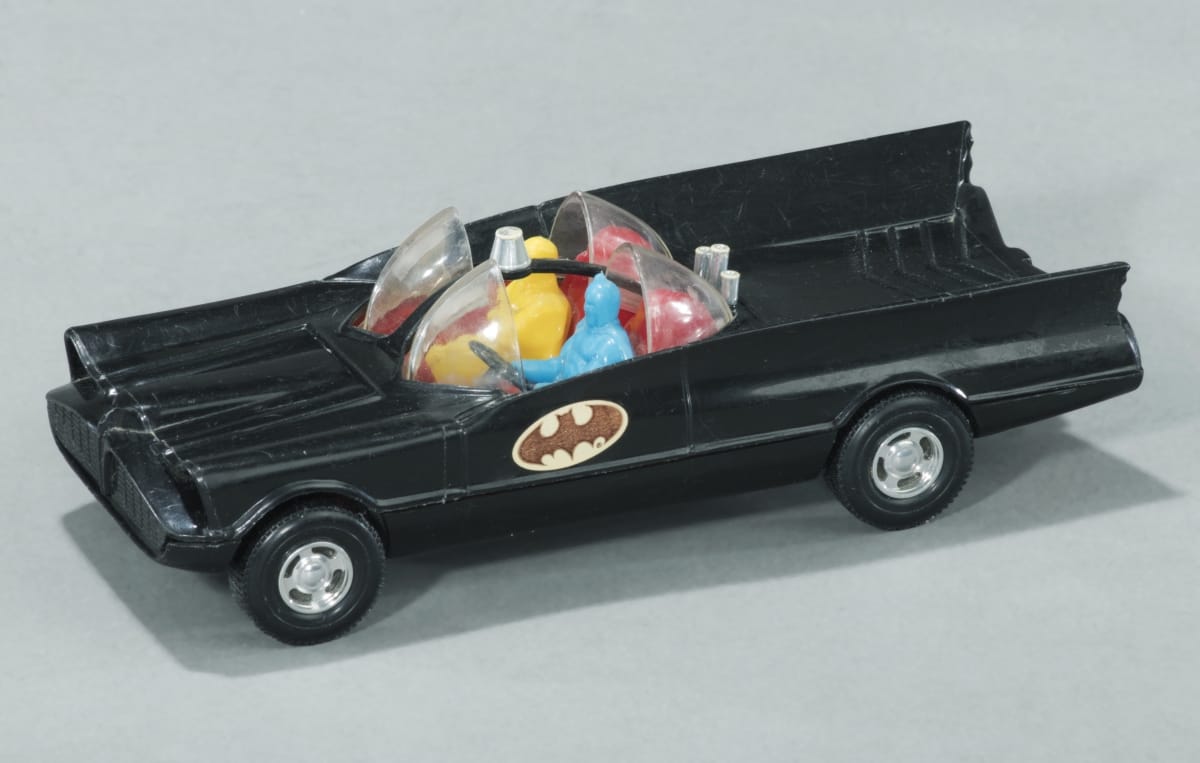
Toy Batmobile, 1966-69. THF174647
Bursting onto the scene in January 1966, Batman became an instant hit and took the country by storm. Batmania was in full swing by the Fall 1966-67 TV season. The series, based upon the DC comic book of the same name, featured the Caped Crusader (millionaire Bruce Wayne in his alter-ego of Batman) and the Boy Wonder (his young ward Dick Grayson in his alter-ego of Robin). These two crime-fighting heroes defended Gotham City from a variety of evil villains. It aired twice weekly, with most stories leaving viewers hanging in suspense the first night until they tuned in the second night.
This show successfully captured the youth audience, with its campy style, upbeat theme music, and tongue-in-cheek humor. Despite the fact that it verged on being a sitcom, the producers wisely left out the laugh track, reinforcing the seriousness with which the characters seemed to take the often absurd and wildly improbable situations in which they found themselves. The filming simulated a surreal comic-book quality, with characters and situations shot at high and low angles, with bright splashy colors and with sound effects, like Pow, Bam, and Zonk, appearing as words splashed across the action sequences on screen. The series was also replete with numerous gadgets and over-the-top props, with the Batmobile undoubtedly most memorable. Batman ran until March 1968, experiencing a significant ratings drop after its initial novelty faded.
Lost in Space (Wednesday 7:30-8:30, CBS)
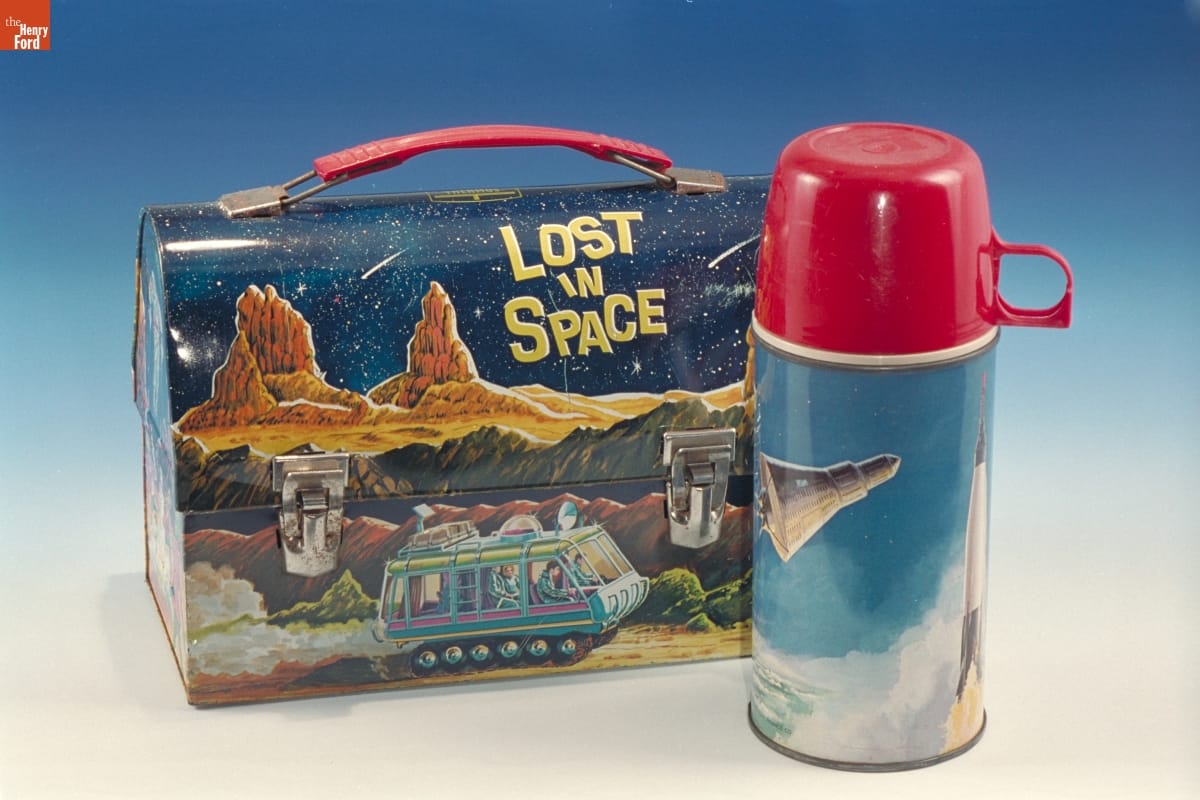
“Lost in Space” Lunchbox and Thermos, 1967. THF92298
Loosely based upon the story of the Swiss Family Robinson, this TV series depicted the adventures of the Robinson family, a pioneering family of space colonists who struggled to survive in the depths of space in the futuristic year of 1997—as the United States was gearing up to colonize space due to overpopulation. But the family’s mission was sabotaged, forcing the crew members to crash-land on a strange planet and leaving them lost in space.
The show had premiered in September 1965 as a serious science fiction series about space exploration and a family searching to find a new place for humans to dwell. But, in January 1966, pitted against Batman’s time slot, Lost in Space producers attempted to imitate Batman’s campiness with ever-more-outrageous villains, brightly colored outfits, and over-the-top action. The plots increasingly featured Robby the Robot and the evil Dr. Zachary Smith. Viewers and actors alike strongly disapproved of this shift. The show lingered on until March 1968.
The Monkees (Monday, 7:30-8:00, NBC)
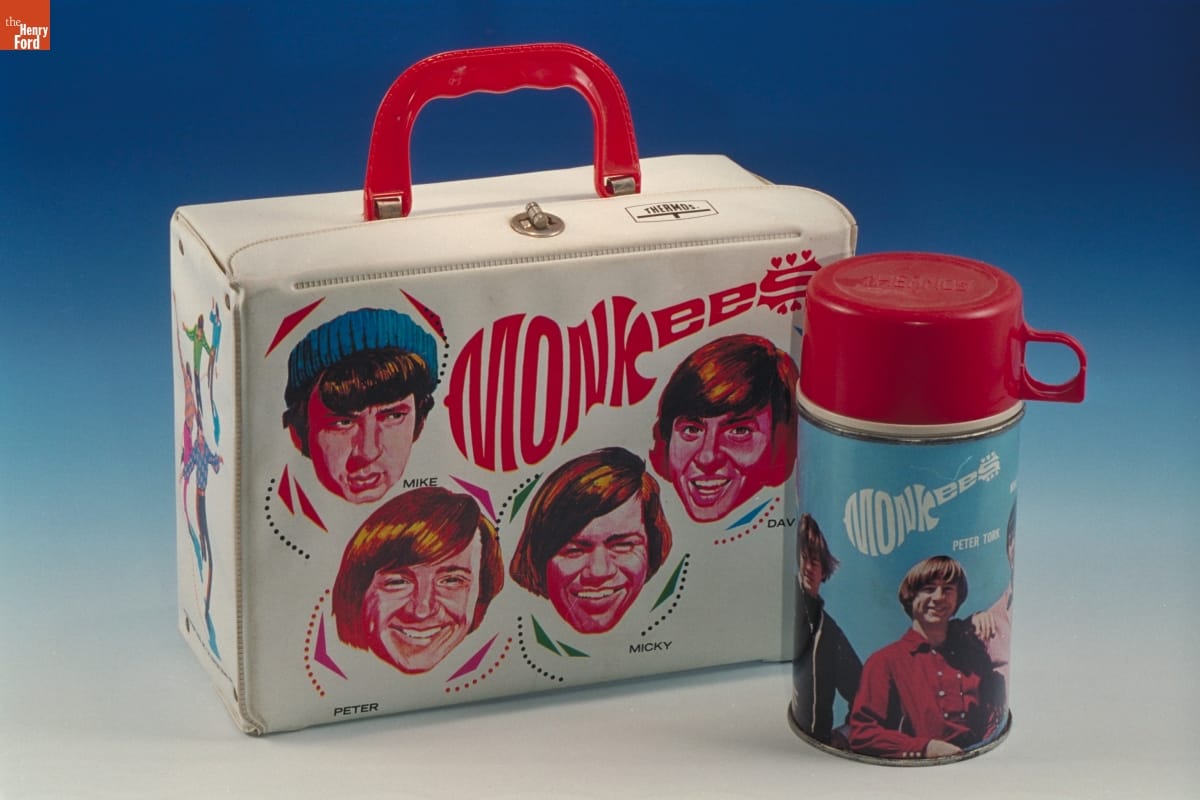
“Monkees” Lunchbox and Thermos, 1967. THF92313
Where other shows might have been lighthearted, campy, or tongue-in-cheek, The Monkees at times verged on pure anarchy. This series, which premiered on September 12, 1966, led off NBC’s prime-time programming every Monday night. It lasted only two seasons but during that time, its star shone brightly. The Monkees followed the experiences of four young men trying to make a name for themselves as a rock ‘n’ roll band, often finding themselves in strange, even bizarre, circumstances while searching for their big break. Aimed directly at the youth audience, the band members were characterized as heroes down on their luck while the adults were consistently depicted as the “heavies.”
The Beatles’ films A Hard Day’s Night and Help! inspired producers Bob Rafelson and Bert Schneider to create not only a show about a rock ‘n’ roll band but also to adapt a loose narrative structure (each member of the Monkees was trained in improvisational acting techniques at the outset of the show) and the musical sequences or “romps” that appeared each week. The series built a reputation for its innovative use of avant-garde filming techniques like quick jump cuts and breaking the fourth wall (that is, having the characters directly address the TV viewers). A well-oiled marketing machine behind the show also ensured that strong tie-ins were maintained with teen magazines, merchandise, and live concerts.
The Monkees won the Emmy for best comedy series during its first, the 1966-67, season. However, backlash was inevitable among critics and older teenagers when the Monkees admitted that they did not play their own instruments—although they clearly played them in their live concerts and, in fact, eventually had a falling-out with network executives about this very issue. Though the show was cancelled in 1968, it experienced a huge revival among younger audiences through Saturday morning reruns and especially with the 1986 MTV Monkees Marathon. Remaining band members Micky Dolenz and Mike Nesmith still attract large audiences of intergenerational fans at their live concerts, while reruns of their TV shows continue to draw new audiences.
Star Trek (Thursday, 8:30-9:30 NBC)
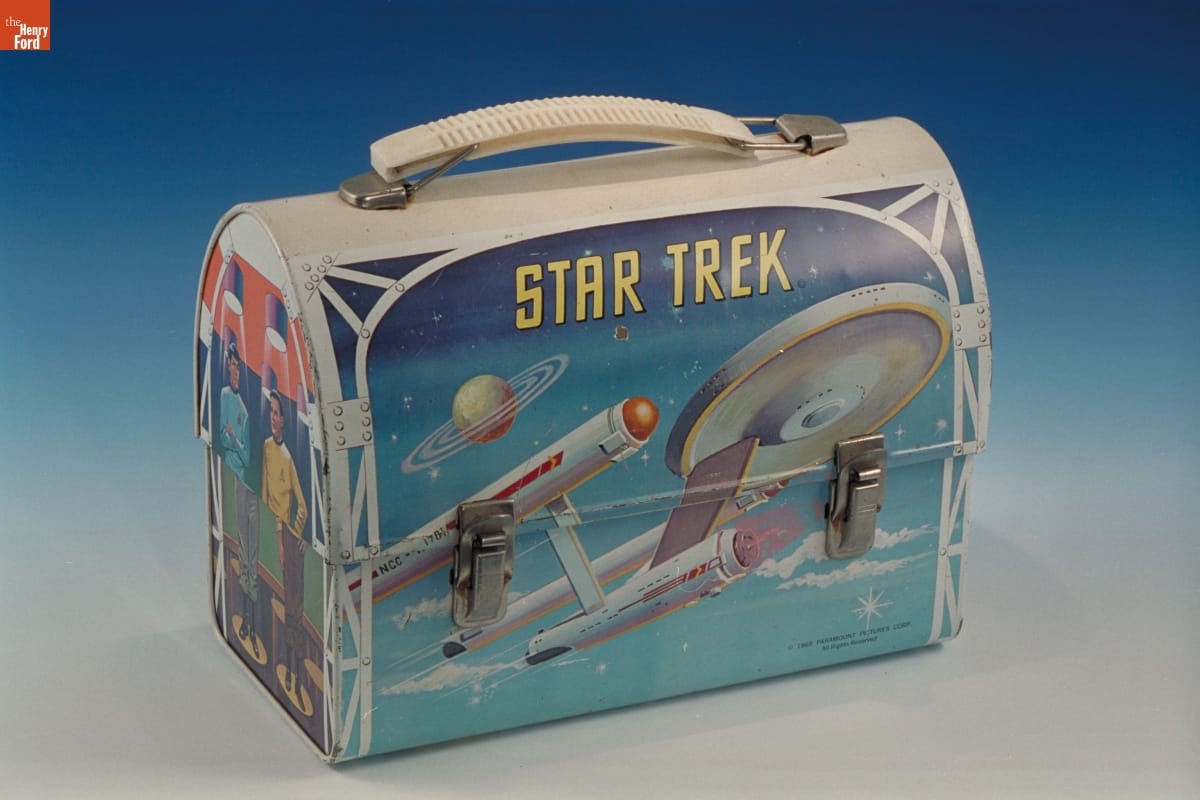
“Star Trek” lunchbox, 1968. THF92299
When Star Trek premiered on September 8, 1966, science fiction shows were not very advanced—or even thought of very highly. Star Trek’s closest competitor, Lost in Space, offered only shallow plots, one-dimensional characters, and fake sets. No one could imagine at the time that this rather low-key show would become one of the biggest, longest-running, and highest-grossing media franchises of all time. This series traced the interstellar adventures of Captain James T. Kirk and his crew aboard the United Federation of Planets’ starship Enterprise, on a five-year mission “to explore strange new worlds, to seek out new life and new civilizations, to boldly go where no man has gone before.”
Creator Gene Roddenberry, aiming the show at the youth audience, wanted to combine suspenseful adventure stories with morality tales reflecting contemporary life and social issues. So, to get by network scrutiny, he set the premise of the show in an imaginary future. With the freedom to experiment, he put in place one of TV’s first multiracial and multicultural casts and was able to explore through different episodes some of the most relevant political and social allegories on TV at the time. The stories were also considered exceptionally high quality for that era, involving believable characters with which viewers could both identify and sympathize. Unlike the gloomy predictions of most science fiction writings of the time, Roddenberry hoped that the futuristic utopia he created on Star Trek would give young people hope, that it would empower them to create a better future for themselves someday. Star Trek, with only modest ratings, lasted only three seasons. But it would go on to become a cult classic.
The Smothers Brothers Comedy Hour (Sunday, 9:00-10:00 p.m. beginning February 1967, CBS)

TV Guide featuring The Smothers Brothers on cover, June 10-16, 1967. THF275657
In Fall 1966, The Garry Moore Show, a variety show on CBS hosted by the aging radio and TV star, was no match when pitted against Bonanza—even with this, its first season in color. Network executives, at their wit’s end to try to attract viewership, decided the only way they could come up with a quick replacement was to substitute another variety show. In desperation, they landed on a simple variety series featuring the soft-spoken, clean-cut, non-threatening folk-music-playing Smothers Brothers. Considered a “young act,” an added bonus was that their show might capture the coveted youth audience. Little did they know what they were in for.
As the show evolved, the brothers not only became more politicized themselves but felt that they owed it to their young viewers to increase the show’s relevance, boldly addressing overtly divisive political and social issues. Their staff of young writers was only too happy to comply. Unfortunately, as a result, the brothers were continually at odds with the network censors until the show was finally cancelled after three seasons. In its continual conflicts with network executives, The Smothers Brothers Comedy Hour turned the variety show genre on its ear and paved the way for Rowan & Martin’s Laugh-In (1968) and, in pushing TV’s all-out rebellion against the status quo, led an explosive charge that resulted in 1970s shows like All in the Family (1971).
These are but a few highlights from the 1966-67 TV season. Some say that this was the greatest television season ever, a clear indication that TV had finally come of age. Because of shows like these, television would certainly never be the same again. And, come to think of it, neither would we!
Donna Braden, Curator of Public Life, was 13 years old during that memorable TV season and proudly wears her fan club button to every Monkees concert she still attends.
20th century, 1960s, TV, Star Trek, space, popular culture, music, Disney, by Donna R. Braden
Is That from Star Trek?
We recently got together a number of our curators and staff, who are Star Trek fans and frequent visitors to our current exhibit "Star Trek: Exploring New Worlds," to brainstorm the many connections we might make between the collections of The Henry Ford and the media empire that is Star Trek. During that discussion, someone threw out an example of a name shared across both—but as we dug deeper, we also discovered the artifact had an interesting parallel to (or contrast with) the ship or character. Locating more of these seemed a fitting tribute to Star Trek’s characteristic combination of humor and seriousness.
Below are some similar examples we came up with. What other artifacts can you think of from our collection that share a name with—and perhaps a philosophical tie to—Star Trek?
1984 Plymouth Voyager Minivan
Chrysler boldly went where no carmaker had gone before when it introduced the minivan for 1984. With taller interiors and flatter floors (front-wheel drive eliminated that pesky driveshaft tunnel), minivans generally had more interior room than station wagons, and soon supplanted them as the ideal family car. And, at around 20 miles per gallon, the Plymouth Voyager probably got better fuel mileage than the U.S.S. Voyager of the eponymous series! –Matt Anderson, Curator of Transportation
Gondola Landing after Piccard Stratosphere Balloon Flight, Cadiz, Ohio, October 23, 1934
Four hundred thirty years before Captain Jean-Luc Picard would command the U.S.S. Enterprise, Jean and Jeannette Piccard engaged the stratosphere in a metal gondola attached to a hydrogen balloon. –Jim Orr, Image Services Specialist
Vulcan Brand Appliances Advertisement, 1905, "Vulcan- Handy Things for Every Home"
Star Trek’s half-Vulcan, half-human science officer, Spock, represented the polar opposite of the Roman god of fire, Vulcan. While the Roman god served as a harbinger of volcanic destruction, Spock modeled cool composure. In 1905, Vulcan Brand Appliances embraced the Roman mythology and marketed their toasters and curling-iron heaters as handy things for every home. What would Spock think? –Debra Reid, Curator of Agriculture and the Environment
Google Nexus Q, 2012
It didn’t sweep you into an extra-dimensional fantasy realm like the Nexus that trapped Kirk and Picard in Star Trek Generations, nor did it use omnipotent powers to tease your crew like the meddlesome Q of Star Trek: The Next Generation, but the Google Nexus Q could keep you entertained for hours on end with music, movies, and TV shows. –Matt Anderson, Curator of Transportation
Scot Towels, circa 1937
Montgomery Scott, known as "Scotty," is the Chief Engineer aboard the U.S.S. Enterprise in the original Star Trek series. The heavy Scottish accent adopted for the role by Canadian actor James Doohan became one of Scotty's hallmarks, as did his intense pride in the Enterprise, his sense of humor, his complaints when the ship encounters yet another tight spot, and the way he always tells Captain Kirk repairs will take longer than they actually will. Still, like this roll of Scot Towels in our collection, which would have facilitated quick and easy cleanup of mid-20th-century messes, Scotty always comes through when the 23rd-century Enterprise is in need of a quick fix. –Ellice Engdahl, Digital Collections and Content Manager
Trade Card for "White Cloud," "Mechanic," "Coronet," and "Mikado" Soap, James S. Kirk & Co., circa 1885
James S. Kirk was born in Scotland (not Iowa, like Enterprise captain James T. Kirk) and established his soap company in Utica, New York. He relocated the business to Chicago in 1859 and, by 1900, had built it into one of the largest soap manufacturers in the world, producing 100 million pounds of the cleaner each year. –Matt Anderson, Curator of Transportation
Tread Power, circa 1885
Gene Roddenberry (1921–1991) considered the United Space (or Star) Ship Enterprise as the main character of Star Trek. But why the name "enterprise"? In response to 1960s counterculture, veterans of World War II, including Roddenberry, did not want anyone to forget the need to ally against evil. The name "enterprise" conjured up associations with action that changed the course of human events. Decades before Star Trek, companies used the term to imply initiative and progress. The Enterprise Manufacturing Company produced an endless-belt tread power, on which a dog, goat, or sheep walked to generate power for myriad uses on family farms. –Debra Reid, Curator of Agriculture and the Environment
1896 Riker Electric Tricycle
Andrew L. Riker was a pioneer builder of both electric and gasoline-powered automobiles. He may not have served as first officer aboard a starship like Will Riker of Star Trek: The Next Generation, but Andrew Riker did serve as first president of the Society of Automotive Engineers! –Matt Anderson, Curator of Transportation
Steam Engine Lubricator, 1882
Star Trek's Leonard McCoy would remind you that he's a doctor, not a locomotive fireman. This steam engine lubricator was patented by African-American mechanical engineer Elijah McCoy, who may have had more in common with Bones' shipmate Scotty. –Jim Orr, Image Services Specialist
Trade Card for Excelsior Botanical Company, circa 1885
The Latin root, excello, meaning "to rise," inspired many companies with aspirations. Excelsior Botanical Company marketed cure-all preparations and "excelsior" became the synonym for packing material made from wood chips or pine needles. All of this happened more than a century before the release of Star Trek VI: The Undiscovered Country, in which Hikaru Sulu commanded the U.S.S. Excelsior starting in 2290. –Debra Reid, Curator of Agriculture and the Environment
The Historical Figures of Star Trek
Though the various series and movies of Star Trek are set in the future, those crews and characters sometimes ended up crossing paths with historical figures familiar to those of us stuck here in the 21st century. Image Services Specialist (and Trekkie) Jim Orr shares some objects from our collection that tie to those notables, and explains each Star Trek connection as we continue to celebrate our latest exhibit in Henry Ford Museum of American Innovation, "Star Trek: Exploring New Worlds."
Life Mask of Abraham Lincoln by Clark Mills
In the 1966 Star Trek episode "The Savage Curtain," Captain Kirk and Commander Spock become unwilling participants in an alien experiment to determine which is stronger—good or evil. Their allies included a doppelganger of Kirk's hero, President Abraham Lincoln.
Relief Plaque of "The Last Supper"
In the 1969 Star Trek episode "Requiem for Methuselah," Kirk encounters an ancient, immortal being who claims to have been many notable figures from history, including Renaissance artist Leonardo da Vinci. Another version of Leonardo da Vinci would appear in the 1997 Star Trek: Voyager episode "Concerning Flight," in which alien arms dealers steal the U.S.S. Voyager's holographic equipment.
Bookplate of Jack London, circa 1905
In the 1992 Star Trek: The Next Generation episode "Time's Arrow," Lieutenant Commander Data finds himself stranded in the year 1893 after an encounter with time-traveling aliens. There, he befriends hotel bellhop (and aspiring writer) Jack London.
Portrait of Mark Twain, by Edoardo Gelli, 1904
While attempting to rescue a time-traveling Data from 1893 San Francisco in the 1992 Star Trek: The Next Generation episode "Time's Arrow," the crew of the U.S.S. Enterprise accidentally returns with author Samuel Clemens (a.k.a. Mark Twain).
Book, "Opticks: or a Treatise on Reflections, Refractions, Inflections and Colours of Light," by Sir Isaac Newton, 4th ed., 1730
Data played a hand of poker against holographic representations of "three of history's greatest minds" in the 1993 Star Trek: The Next Generation episode "Descent." Sir Isaac Newton's works include Opticks: or a Treatise on Reflections, Refractions, Inflections and Colours of Light.
Ford Motor Company Executive Ernest G. Liebold with Albert Einstein, 1941
Data's poker game with "three of history's greatest minds" also includes a holographic representation of Albert Einstein. Ford Motor Company executive E.G. Liebold posed for this photograph with the real Albert Einstein in 1941.
Amelia Earhart Speaking at the Elks Air Circus, July 11, 1929
Amelia Earhart's mysterious fate has figured into the plots of TV shows ranging from Night Gallery to The Love Boat. Star Trek: Voyager featured Earhart in the 1995 episode "The 37's," explaining her 1937 disappearance as—what else—an alien abduction. (Thanks to Curator of Transportation and fellow Trekkie Matt Anderson for this contribution!)
Jim Orr is Image Services Specialist at The Henry Ford and has seen all 732 episodes (and counting) of every series of Star Trek.
We don’t generally associate Star Trek with historic automobiles (or, for that matter, with any automobiles). The classic original series is set circa 2265-2269, nearly 360 years after the first Model T rolled out of Ford’s Piquette Avenue Plant. By all evidence, Federation citizens in the 23rd century are content to get around by spaceship and shuttlecraft (with the notable exception of the Jupiter 8). But who can blame them for not driving? After all, we’re talking about a universe in which teleportation is a thing. But Star Trek isn’t an entirely auto-free zone. Through the clever storytelling devices of science fiction, Kirk, Spock, and McCoy encounter multiple 20th century American cars over the course of the show.
Ask fans to name their favorite episodes and you’ll likely hear “The City on the Edge of Forever” mentioned several times. The romantic yarn, which closed the first season, finds the crew of the Enterprise in a time-traveling misadventure. Dr. McCoy, less than lucid after an accidental overdose of medication, charges through a temporal gateway into New York City circa 1930. Kirk and Spock follow their ailing comrade and discover that McCoy has inadvertently altered history with serious consequences. Our heroes manage to put things right, but not without considerable anguish on Kirk’s part.
Ford’s 1929 Model AA stake body truck, similar to one seen in “The City on the Edge of Forever.” (THF28278)
The episode features several period automobiles including a 1930 Buick, 1928 and 1930 Chevrolets, and a circa 1930 Ford Model AA truck. Most are in the background, but a 1939 GMC AC-series truck plays a crucial part in the story. In fact, it’s not too much to say that the whole plot depends on it. (Beware of the spoiler at this link.) No, a ’39 truck has no business being on the streets of New York in 1930, but we’ll just let that slide.
The crew returns to a circa 1930 setting in the memorable season two episode “A Piece of the Action.” But this time they’re not on Earth. The Enterprise arrives at the planet Sigma Iotia II, last visited by outsiders before implementation of the Federation’s sacrosanct Prime Directive – barring any interference with the natural development of alien cultures. Kirk and company discover that the planet was indeed contaminated by those earlier visitors. They left behind a book on Chicago gangsters in the 1920s, and the Iotians – a society of mimics – have modeled their planet on that tome, with the expected chaotic results.
Cadillac, the choice of discerning Starfleet officers. (THF103936)
Those industrious Iotians somehow managed to replicate a host of 1920s and 1930s American cars. Look for a 1929 Buick, a 1932 Cadillac V-16, and a 1925 Studebaker in the mix. But the star car undoubtedly is the 1931 Cadillac V-12 used by Kirk and Spock. It’s one of the few times you’ll see Kirk drive, and it makes for one of the episode’s more amusing scenes. Give one point to Spock for knowing about clutch pedals, but take one point away for his referring to the Caddy as a “flivver.” One could quibble with ’30s cars appearing in a ’20s setting – but one should also remember that this isn’t Earth. We can’t expect the Iotians to get all the details right!
It’s also worth taking a look at season two’s final episode, “Assignment: Earth.” The Enterprise travels back in time to 1968 to conduct a little historical research on Earth. They cross paths with the mysterious Gary Seven, an interstellar agent on a mission of his own to prevent the launch of an orbiting missile platform that will – apparently – lead to nuclear war. It sounds like something right out of “Star Wars.” (No, not that Star Wars, this “Star Wars.”)
Based on the Department of Defense cars seen in “Assignment: Earth,” it seems the Pentagon prefers Plymouths. Now why could that be? (THF150740)
It’s all very complicated, but it provides another opportunity to see some vintage wheels. (Well, vintage to us and to the Enterprise crew. To TV audiences in 1968, these were contemporary cars.) Pay attention and you’ll spot a number of government agency vehicles including a 1963 Plymouth Savoy, a 1967 Dodge Coronet, and a 1968 Plymouth Satellite (the latter being particularly apropos for a space series). For those who aren’t Mopar fans, look quickly and you’ll also spy a 1966 Ford Falcon in the episode.
Okay, so no one will ever confuse Star Trek with Top Gear. But, if you keep your eyes peeled, every now and then you’ll find a little gasoline to go along with all of that dilithium. After all, sometimes the boldest way to go is the oldest way to go.
Matt Anderson is Curator of Transportation at The Henry Ford.
by Matt Anderson, cars, popular culture, TV, space, Star Trek

